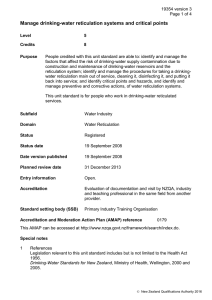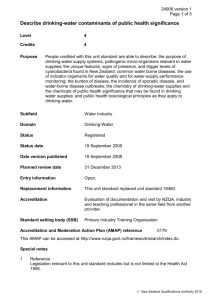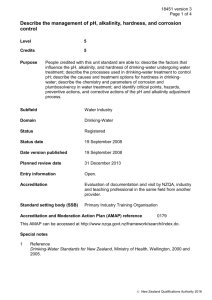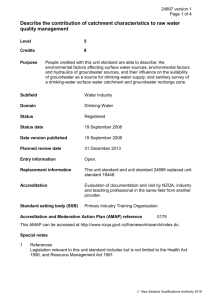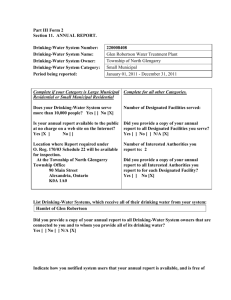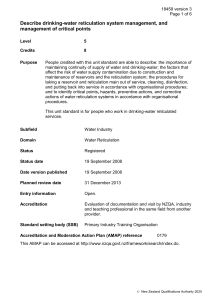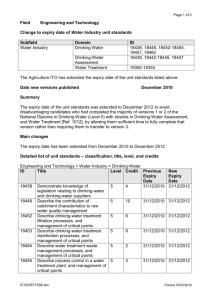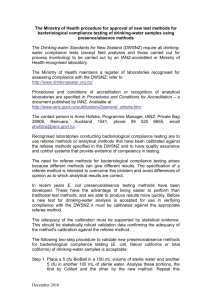Demonstrate knowledge of, and evaluate, a small drinking-water supply
advertisement
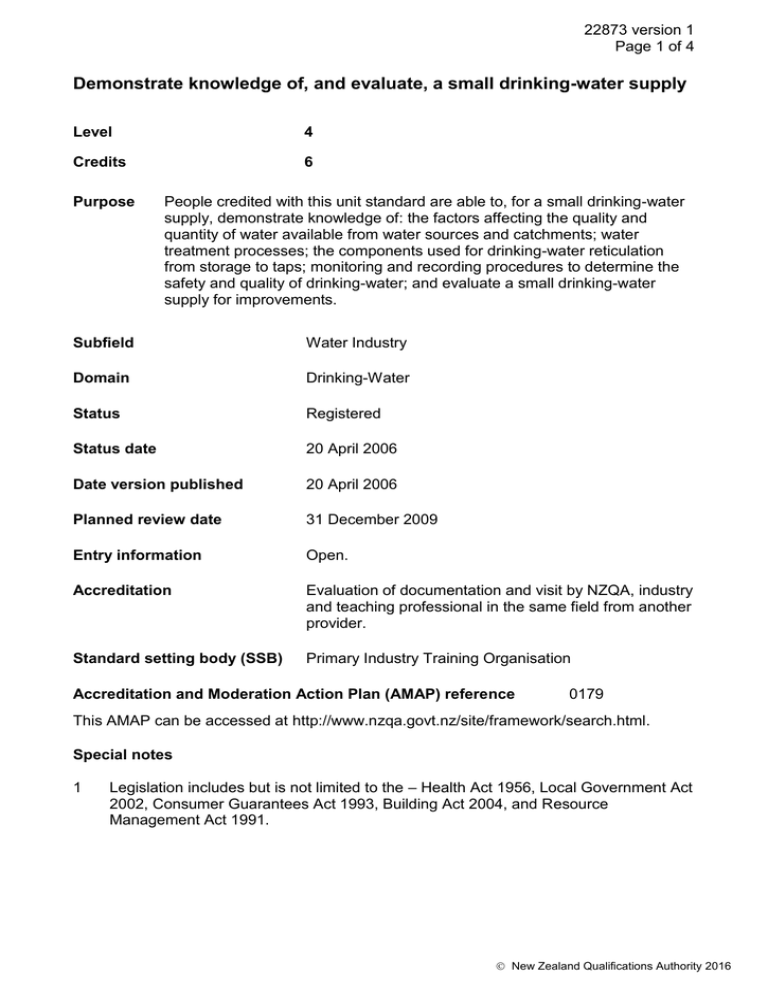
22873 version 1 Page 1 of 4 Demonstrate knowledge of, and evaluate, a small drinking-water supply Level 4 Credits 6 Purpose People credited with this unit standard are able to, for a small drinking-water supply, demonstrate knowledge of: the factors affecting the quality and quantity of water available from water sources and catchments; water treatment processes; the components used for drinking-water reticulation from storage to taps; monitoring and recording procedures to determine the safety and quality of drinking-water; and evaluate a small drinking-water supply for improvements. Subfield Water Industry Domain Drinking-Water Status Registered Status date 20 April 2006 Date version published 20 April 2006 Planned review date 31 December 2009 Entry information Open. Accreditation Evaluation of documentation and visit by NZQA, industry and teaching professional in the same field from another provider. Standard setting body (SSB) Primary Industry Training Organisation Accreditation and Moderation Action Plan (AMAP) reference 0179 This AMAP can be accessed at http://www.nzqa.govt.nz/site/framework/search.html. Special notes 1 Legislation includes but is not limited to the – Health Act 1956, Local Government Act 2002, Consumer Guarantees Act 1993, Building Act 2004, and Resource Management Act 1991. New Zealand Qualifications Authority 2016 22873 version 1 Page 2 of 4 2 Definitions Small drinking-water supply – a drinking-water supply servicing up to 500 people; and which includes catchment, source, treatment, and reticulation. Secure ground water – water contained beneath the land surface which is abstracted via a secure well head or similarly proven structure, and has been demonstrated to show that contamination by pathogenic or harmful organisms is unlikely. UV – ultraviolet. 3 Some Marae are using traditional Māori indicators to determine water quality, for example, amount of algae and weed growth, presence of algae on rock, flow rate, and smell. 4 Standard Ministry of Health, Drinking-water Standards for New Zealand 2005 (Wellington, 2005) available from http://www.moh.govt.nz/water. Elements and performance criteria Element 1 Demonstrate knowledge of the factors affecting the quality and quantity of water available from water sources and catchments for a small drinking-water supply. Performance criteria 1.1 Water sources and catchments are described in terms of the factors affecting quality, and the consistency of quality of water. Range 1.2 Water sources and catchments are described in terms of the factors affecting availability and reliability of supply, and the need for storage. Range 1.3 surface or surface-influenced water, secure ground water. factors include but are not limited to – less rain, more rain. Source water is described in terms of the contaminants identified in the Drinking-water Standards for New Zealand 2005. Range contaminants – microbiological pathogens, blue-green algae; chemical, aesthetics, corrosion. Element 2 Demonstrate knowledge of water treatment processes for a small drinking-water supply. Performance criteria 2.1 Water treatment processes and water quality parameters are described in terms of barriers and suitability of supply. Range turbidity, iron, flow rate. New Zealand Qualifications Authority 2016 22873 version 1 Page 3 of 4 2.2 Settlement processes are described in terms of their effect on contaminant removal. 2.3 Water treatment filtration processes are described in terms of their effect on contaminant removal, maintenance, and cost. Range 2.4 Water treatment disinfection processes are described in terms of their effect on microbiological contaminants, and the dose rates required. Range 2.5 UV; chlorine – liquid, gas, solid. Water treatment pH control processes are described in terms of their aesthetic impact, and corrosion control. Range 2.6 two of – sand, cartridge, membrane, mechanical. impact on the system corrosion, ideal levels in the drinking-water system, methods for testing, methods of correcting, impact on disinfection. Water treatment processes are described in terms of their inter-relationships. Element 3 Demonstrate knowledge of the components used for drinking-water reticulation from storage to taps for a small drinking-water supply. Range tanks, pipes, pumps, control valves, backflow preventors. Performance criteria 3.1 Components used in reticulation are described in terms of their function. 3.2 Components used in reticulation are described in terms of hygienic methods of maintenance. Element 4 Demonstrate knowledge of monitoring and recording procedures to determine the safety and quality of drinking-water for a small drinking-water supply. Performance criteria 4.1 Sampling results, and frequency of and reasons for, drinking-water monitoring are compared in accordance with the requirements of the Drinking-water Standards for New Zealand 2005. 4.2 Maintenance of drinking-water monitoring records is described in accordance with Drinking-water Standards for New Zealand 2005. New Zealand Qualifications Authority 2016 22873 version 1 Page 4 of 4 Element 5 Evaluate a small drinking-water supply for improvements. Range source and catchment, treatment, reticulation, monitoring. Performance criteria 5.1 A small drinking-water supply is described in terms of its components. 5.2 A small drinking-water supply is evaluated, and viable options for improvement are identified and described. Please note Providers must be accredited by the Qualifications Authority, or an inter-institutional body with delegated authority for quality assurance, before they can report credits from assessment against unit standards or deliver courses of study leading to that assessment. Industry Training Organisations must be accredited by the Qualifications Authority before they can register credits from assessment against unit standards. Accredited providers and Industry Training Organisations assessing against unit standards must engage with the moderation system that applies to those standards. Accreditation requirements and an outline of the moderation system that applies to this standard are outlined in the Accreditation and Moderation Action Plan (AMAP). The AMAP also includes useful information about special requirements for organisations wishing to develop education and training programmes, such as minimum qualifications for tutors and assessors, and special resource requirements. Comments on this unit standard Please contact the Primary Industry Training Organisation standards@primaryito.ac.nz if you wish to suggest changes to the content of this unit standard. New Zealand Qualifications Authority 2016
